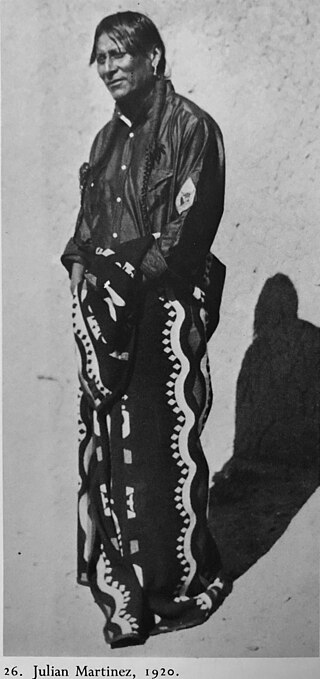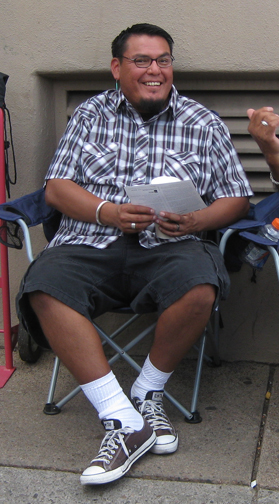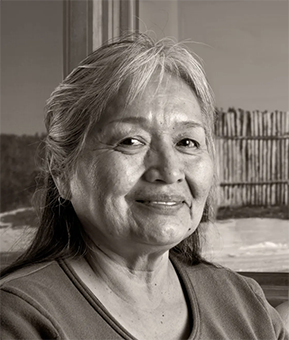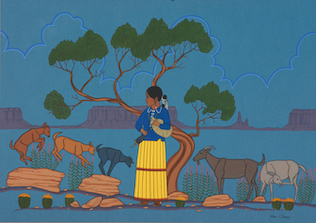Related Research Articles
Rudolph Carl Gorman was a Native American artist of the Navajo Nation. Referred to as "the Picasso of American Indian artists" by The New York Times, his paintings are primarily of Native American women and characterized by fluid forms and vibrant colors, though he also worked in sculpture, ceramics, and stone lithography. He was also an avid lover of cuisine, authoring four cookbooks, called Nudes and Food.

Julián Martínez, also known as Pocano (1879–1943), was a San Ildefonso Pueblo potter, painter, and the patriarch of a family of Native American ceramic artists in the United States.

The Shape Shifter is a crime novel by American writer Tony Hillerman, the eighteenth in the Joe Leaphorn/Jim Chee Navajo Tribal Police series, first published in 2006. It was a New York Times best-seller and the last Chee/Leaphorn novel by Hillerman published before Hillerman's death on October 26, 2008.

Fred Kabotie was a celebrated Hopi painter, silversmith, illustrator, potter, author, curator and educator. His native name in the Hopi language is Naqavoy'ma which translates to Day After Day.

Charles Sequevya Loloma was a Hopi Native American artist known for his jewelry. He also worked in pottery, painting and ceramics.

Maynard Dixon was an American artist. He was known for his paintings, and his body of work focused on the American West. Dixon is considered one of the finest artists having dedicated most of their art to the U.S. Southwestern cultures and landscapes at the end of the 19th-century and the first half of the 20th-century. He was often called "The Last Cowboy in San Francisco."

Harrison Begay, also known as Haashké yah Níyá was a renowned Diné (Navajo) painter, printmaker, and illustrator. Begay specialized in watercolors, gouache, and silkscreen prints. At the time of his death in 2012, he was the last living, former student of Dorothy Dunn and Geronima C. Montoya at the Santa Fe Indian School. His work has won multiple awards and is exhibited in museums and private collections worldwide and he was among the most famous Diné artists of his generation.

Ryan Singer is a Navajo contemporary painter living in Albuquerque, New Mexico. He is of the Tódich'íinii clan, born for Kinyaa'áani. Singer is known for his vibrant Pop Art-inspired takes on Native American and mainstream culture.
As far back as I can remember I have always loved art—drawing, painting, making music. What I like most about it is the freedom to create something—anything—from nothing. – Ryan Singer, 2009
Phillip Sekaquaptewa was a Hopi artist and silversmith in Hopi silver overlay and stone inlay, featuring the lapidary genres of commesso and intarsia. Sekaquaptewa used colorful stones and shell for his Hopi silver overlay, not only plain silver decorated with chisel strokes on black oxide surfaces, a Hopi-signature technique known as matting.
Alice Williams Cling is a Native American ceramist and potter known for creating beautiful and innovative pottery that has a distinctive rich reds, purples, browns and blacks that have a polished and shiny exteriors, revolutionizing the functional to works of art. Critics have argued that she is the most important Navajo potter of the last 25 years.

Christine McHorse, also known as Christine Nofchissey McHorse, was a Navajo ceramic artist from Santa Fe, New Mexico.
D.Y. Begay is a Navajo textile artist born into the Tóʼtsohnii Clan and born from the Táchiiʼnii Clan.
Melissa Cody is a Navajo textile artist from No Water Mesa, Arizona, United States. Her Germantown Revival style weavings are known for their bold colors and intricate three dimensional patterns. Cody maintains aspects of traditional Navajo tapestries, but also adds her own elements into her work. These elements range from personal tributes to pop culture references.
Steven Yazzie is a Native American artist, who is enrolled in the Navajo Nation and of Laguna Pueblo descent of his father's side. He creates video art and installation environments but described painting as his first and most important medium.

Waldo Mootzka (1903–1940) was a Hopi watercolor artist.
Jim Abeita is a Navajo oil painter from Crownpoint, New Mexico. He is best known for his realistic landscapes and portraits depicting his native people and their history and traditions. He was one of the first Native American artists to work in contemporary realism, painting with depth and shadow instead of in the flat-style traditional Native American art. Abeita is praised as a pioneering artist who modernized the Native American art scene, made it famous in the art market and paved the way for a new generation of artists.
Damian Jim is a Diné (Navajo) artist. He is known for his design work on traditional woven baskets, in addition to digital art, photography, and work with acrylic, oil, and ink.
Clifford Beck, Jr. was a Navajo American painter, illustrator, photographer and educator born in Keams Canyon, Arizona. He exhibited his work across the United States and is known for his work in oils and pastels, particularly his portraits of older native people.

Arthur C. Begay was a Navajo American painter born in Newcomb, New Mexico. Begay has exhibited his work across the country and is known for his colorful, flat style paintings. Some of his works are in the permanent collection of institutions including the Smithsonian National Museum of the American Indian.
Keats Begay was a Navajo American painter who lived in Chinle, Arizona and was active in the late 1930s. Begay has exhibited his work across the country, including at the National Gallery of Art, and is known for his colorful, flat style paintings. Some of his works are in the permanent collection of institutions including the Indian Arts and Crafts Board, Museum of Northern Arizona, the Southwest Museum of the American Indian and the Museum of New Mexico.
References
- 1 2 3 4 5 6 Hedblad, Alan (2003). Something about the author. Detroit, Michigan: Gale Publishing. pp. 23–24. ISBN 9780787652098.
- 1 2 3 4 5 6 7 Abatemarco, Michael (August 16, 2013). "Ecstatic realities: Artist Shonto Begay". Santa Fe New Mexican.
- 1 2 3 4 5 6 7 McElmeel, Sharron L. (November 1996). "Author and illustrator profile". Library Talk. 9 (5): 14 – via EBSCOHost.
- ↑ Clover, Faith (1997). "Shonto Begay talks about his art". SchoolArts. 97 (2): 22–23, 42.
- 1 2 3 Dittemore, Diane (2010). "Shonto Begay". American Indian Art Magazine. 36 (1). Scottsdale, Arizona: 43. ISSN 0192-9968.
- 1 2 3 "Shonto Begay". Modern West Fine Art. Retrieved February 22, 2020.
- 1 2 "Shonto Begay, Native American painter | Canyon Road Arts" . Retrieved February 23, 2020.
- 1 2 Art Dealer Diaries Season 2018 E 2, Shonto Begay hosted by Mark Sublette , retrieved February 22, 2020
- 1 2 Artist Shonto Begay discusses his latest show "Rhythm of the Blue Highway" , retrieved March 12, 2020
- ↑ "Shonto Begay – Losing My Spirit for Salvation". Medicinemangallery.com. Retrieved March 12, 2020.
- ↑ "Shonto Begay – Nightwalker". Medicinemangallery.com. Retrieved March 12, 2020.
- ↑ "Dancing light". PressReader . October 1, 2018. Archived from the original on February 24, 2020. Retrieved June 24, 2023.
- ↑ Artist Shonto Begay discusses his latest show "Rhythm of the Blue Highway" , retrieved February 23, 2020
- ↑ "Free First Sunday: Artist Talk with Shonto Begay". wheelwright.org. Retrieved February 23, 2020.
- ↑ "Aje' Ji' | The Heart Way | Modern West | Artsy". www.artsy.net. Retrieved February 23, 2020.
- ↑ "Explore Contemporary Navajo Culture with Shonto Begay's Map of My Heart". Museum of Northern Arizona. May 30, 2014. Retrieved February 23, 2020.
- 1 2 3 "Shonto Begay Biography | Medicine Man Gallery". Medicinemangallery.com. Retrieved February 23, 2020.
- 1 2 3 "Shonto Begay wins at Santa Fe Indian Market". Navajo-Hopi Observer News. Retrieved February 23, 2020.
- ↑ "Modern West Holiday's | Group Show | Modern West | Artsy". www.artsy.net. Retrieved February 23, 2020.
- ↑ "MutualArt.com – The Western Sublime: Majestic Landscapes of the American West". www.mutualart.com. Retrieved February 23, 2020.
- ↑ "They Ain't Marlboro Men: Another "New West" at the Briscoe Museum". Glasstire. August 5, 2019. Retrieved February 23, 2020.
- ↑ "MutualArt.com – Six Navajo Masters: Abeyta, Begay, Johns, Whitehorse, Whitethorne & Yazzie". www.mutualart.com. Retrieved February 23, 2020.
- ↑ "Modern West Fine Art | Small Works | Modern West | Artsy". www.artsy.net. Retrieved February 23, 2020.
- ↑ "Native Voices | Modern West | Artsy". www.artsy.net. Retrieved February 23, 2020.
- ↑ "NATIVE AMERICAN PORTRAITURE". Rainmaker Gallery. November 20, 2015. Retrieved February 23, 2020.
- ↑ "Travel the 7C's of Arizona at Phoenix Sky Harbor Have an Art Adventure and Travel the 7C's of Arizona at Phoenix Sky Harbor". www.skyharbor.com. Retrieved February 23, 2020.
- ↑ "UMFA: Utah Museum of Fine Arts". August 7, 2013. Archived from the original on August 7, 2013. Retrieved February 23, 2020.
- ↑ "MESSENGERS 2012". Rainmaker Gallery. July 1, 2012. Retrieved February 23, 2020.
- ↑ "The Avery Collection of American Indian Paintings | Arizona State Museum". statemuseum.arizona.edu. Retrieved February 23, 2020.
- ↑ "Begay, Shonto W. (Navajo)". econtent.unm.edu. Retrieved February 23, 2020.
- ↑ "West of The Moon Gallery – Artists Represented". westofthemoongallery.com. Retrieved February 23, 2020.
- ↑ Smallwood, Sarah (January 18, 2020). "2020 Legacy Recipient : Shonto Begay". Flagstaff Arts Council. Retrieved February 23, 2020.
- ↑ "And the winners are…..Arizona Daily Sun's 2015 Best of Flagstaff!". Arizona Daily Sun. Retrieved February 23, 2020.
- ↑ Tannous, John (March 4, 2010). "Viola Award Archives – 2010". Flagstaff Arts Council. Retrieved February 23, 2020.
- ↑ "Shonto Begay". Poetry Foundation. February 23, 2020. Retrieved February 23, 2020.
- ↑ "Classroom connections: Books written & illustrated by Shonto Begay". Library Talk. 9 (5): 16. November 1996 – via EBSCOHost.
- ↑ Shonto, Begay (1995). Navajo: Voices and Visions Across the Mesa. New York: Scholastic Inc. p. 6. ISBN 0-590-46153-2.
- ↑ Turner, Nancy (September 9, 2002). "Collective Willeto (Book)". Library Journal. 127 (15): 57 – via EBSCOHost.